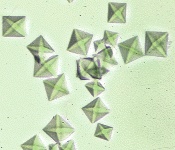 Calcium oxalate dihydrate crystals typically are seen as colorless squares whose corners are
connected by intersecting lines (resembling an envelope). They can occur in urine of any
pH. The crystals vary in size from quite large to very small. In some cases, large numbers of
tiny oxalates may appear as amorphous unless examined at high magnification.
Calcium oxalate dihydrate crystals typically are seen as colorless squares whose corners are
connected by intersecting lines (resembling an envelope). They can occur in urine of any
pH. The crystals vary in size from quite large to very small. In some cases, large numbers of
tiny oxalates may appear as amorphous unless examined at high magnification.
These crystals often are seen in normal urine from horses and cattle. They are less common in normal canine and feline urines. Urolithiasis due to calcium oxalate has been reported in both dogs and cats. In some cases, they occur secondary to abnortmal calcium (increased) excretion due to disorders of calcium metabolism (e.g. hyperparathyroidism). Miniature Schnauzers are predisposed to calcium oxalate urolithiasis, despite no abnormalities in urinary calcium excretion. Calcium oxalate dihydrate crystals can also be seen in cases of ethylene glycol intoxication. If seen in large numbers in the urine of a dog or cat with acute renal failure, consideration should be given to this diagnosis. |
Last Updated: January 15, 1996